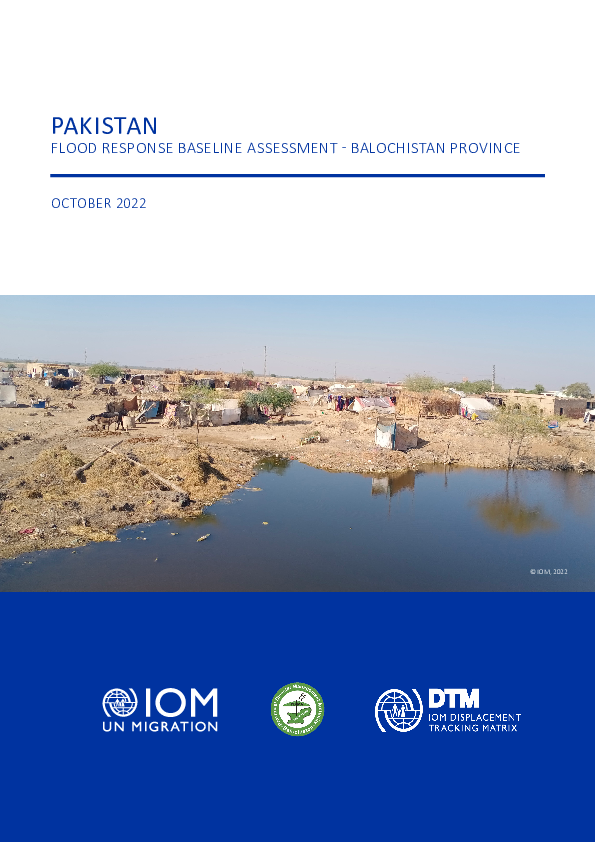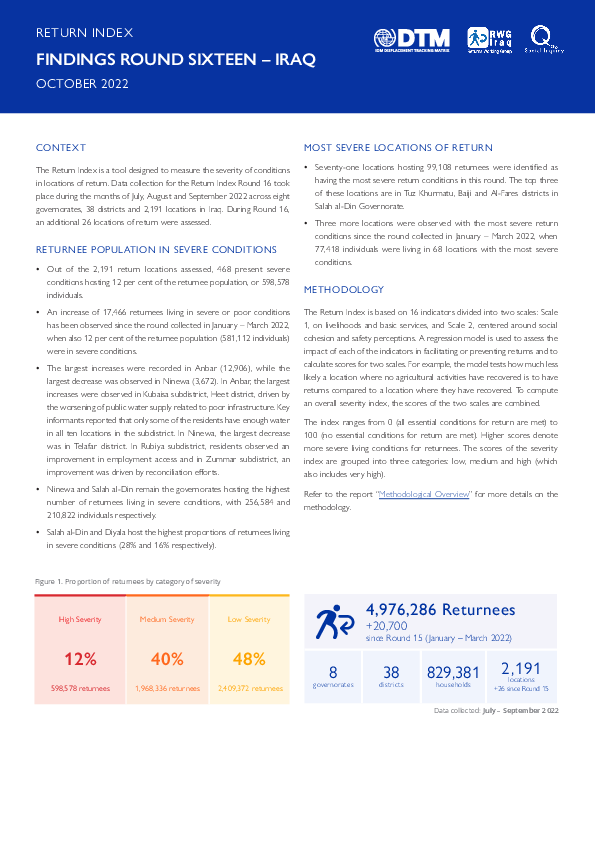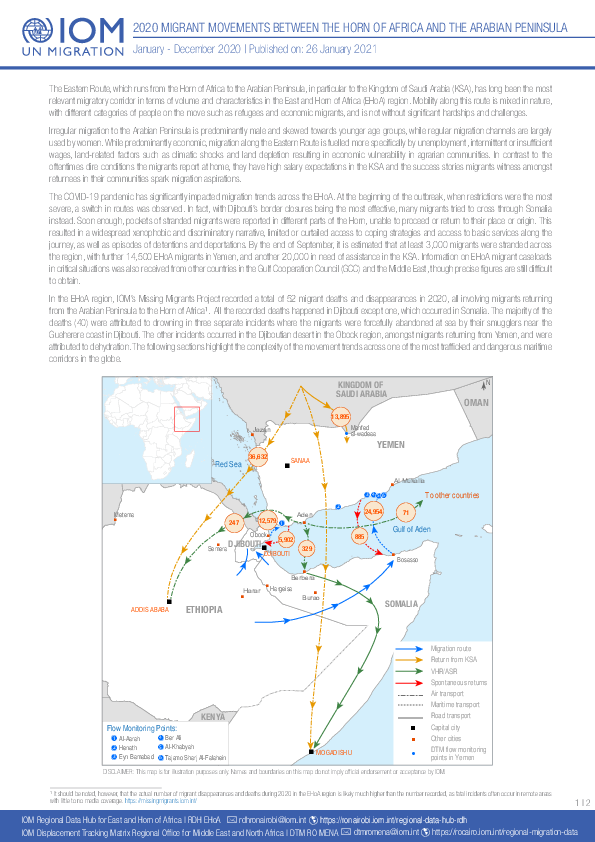-
Countries
-
Data and Analysis
-
Special Focus
-
Crisis Responses
Return migration
The Eastern Route, which runs from the Horn of Africa to the Arabian Peninsula, in particular to the Kingdom of Saudi Arabia, has long been the busiest and most relevant migratory corridor in the East and Horn of Africa region. In 2021, movement trends along the Eastern Corridor have significantly increased by 71% compared to 2020, suggesting that migration seems to be slowly resuming to pre-pandemic levels. However, monitored crossings from the Horn to Yemen decreased by 26% compared to 2020, although these have shown a steady but slow increase in the last quarter of 2021.
The Eastern Route, which runs from the Horn of Africa to the Arabian Peninsula, in particular to Saudi Arabia, has long been the most relevant migratory corridor in terms of volume and characteristics in the East and Horn of Africa region. Mobility along this route is mixed in nature, with different categories of people on the move such as refugees and economic migrants, and is not without significant hardships and challenges.
The fluidity of migration along the Eastern route, from the Horn of Africa to the Arabian Peninsula, continued to be a common phenomenon in 2019. High volumes of migrants faced significant risks when crossing the Gulf of Aden from the Horn of Africa to Yemen and onward to the Kingdom of Saudi Arabia (KSA). These flows are mixed in nature in which different categories of migrants including refugees, economic migrants and other types of migrants move along the same route.

Contact
DTM Europe, DTMMediterranean@iom.int
Language
English
Location
Poland
Period Covered
Apr 12 2022
Dec 31 2022
Activity
- Survey
- Flow Monitoring Survey
- Return Intention
A total of 8.19 million crossings from Ukraine to Poland were recorded at border crossing points (BCPs) since 24 February 2022 according to Polish Border Guard data from 13 December. IOM’s Displacement Tracking Matrix (DTM) conducted surveys with Ukrainian nationals before they crossed back to Ukraine from three border crossing points in Poland. This report provides an overview of key trends based on the 8,664 surveys that were conducted between 12 April and 31 December 2022 to assess the profiles, needs and intentions of refugees from Ukraine crossing from Poland back into Ukraine. Individuals crossing into Ukraine are not necessarily returnees and conclusions on definitive trends cannot be drawn. The sample is not representative of all persons crossing into Ukraine, results should hence only be considered as indicative.

Contact
Regional Office Dakar, RODakar-DataResearch@iom.int
Language
English
Location
The Gambia
Period Covered
Nov 01 2022
Nov 30 2022
Activity
- Flow Monitoring Survey
- Flow Monitoring
In The Gambia, DTM conducts Flow Monitoring activities at several important transit locations in:
1) Barra (FMPs are located at the ferry terminal and the main garage);
2) Farafenni (FMPs are located at Farafenni main garage, Farafenni Ballan-Ghar garage, Farafenni McCarthy and Sanjally garage, Farafenni turntable garage and the truck garage);
3) Basse (FMPs are situated at the main garage and the bus station in Basse Santa-Su) and
4) Brikama (FMPs are located at the main garage and the bus station).
These activities enable DTM to monitor the movements of passengers within, out of and towards The Gambia as well as the movements of those passengers transiting The Gambia. This report presents the key results of the Flow Monitoring Survey conducted from the 1st to the 30th of November 2022, excluding weekends and national holidays, with data collected for 22 days. The report presents data collected on flows, routes, departures, destinations and demographic profiles of travellers observed at the FMPs

Contact
DTMUkraine@iom.int
Language
English
Location
Ukraine
Period Covered
Nov 25 2022
Dec 05 2022
Activity
- Survey
Starting on 24 February 2022, a large-scale armed conflict in Ukraine triggered an unprecedented humanitarian crisis across the country, characterised, among other elements, by the displacement of a significant proportion of the Ukrainian population.
As early as April 2022, the International Organization for Migration (IOM) began observing significant return movements. Conditions of return vary widely, as returnees arrive back to areas not directly affected by the war, but which have experienced a significant influx of internally displaced persons (IDPs), as well as to conflict-affected and recently de-occupied areas which have sustained severe damage. Due to the volatility of the current situation, it is impossible to determine what proportion of the returns observed at present are permanent or temporary. Existing data shows, however, that the returnee population in Ukraine is characterized by a unique set of needs and vulnerabilities which set it apart from those who had never been displaced and from the population of IDPs.
To support partners in providing targeted, evidence-based assistance to those returning to their areas of habitual residence following a period of forced displacement, IOM presents the Ukraine Returns Report. This publication will strive to analyze IOM’s latest data on the situation and needs of the returnee population and on the conditions of return, collected through the Displacement Tracking Matrix (DTM) assessments conducted in the country.
This December 2022 edition of the Ukraine Returns Report presents a detailed analysis of data collected through the eleventh round of IOM’s General Population Survey (GPS), conducted 25 November and 5 December 2022 among the adult population in Ukraine. The geographical scope of the assessment covers the entire territory of Ukraine, all five macro-regions (West, East, North, Centre, South, and the city of Kyiv), with the exception of the Crimean peninsula and the non-government-controlled-areas of Ukraine (NGCA). The general population survey was conducted using a random‐digit‐dial (RDD) approach, and 2,002 unique and anonymous respondents aged 18 and over were interviewed using the computer-assisted telephone interview (CATI) method.

Contact
DTM Pakistan, iomisbdtmremapteam@iom.int
Language
English
Location
Pakistan
Period Covered
Sep 26 2022
Oct 02 2022
Activity
- Baseline Assessment
Storms and heavy monsoon rains in Pakistan have caused widespread flooding and landslides across the country. According to the National Disaster Management Authority (NDMA), up to 33 million people have been affected by the floods since mid-June 2022 and a total of 85 districts have been labelled by the Government of Pakistan as ‘calamity-hit’, as of 17 October 2022.¹ According to the NDMA Daily Situation Report No.126, 24 districts in Sindh province are calamity-hit and an estimated total of 14,563,770 people are affected by the floods.² Besides that, 1.9 million houses are reported to be damaged in Sindh province alone. However, the number of temporarily displaced persons (TDPs) were yet to be confirmed.

Contact
DTM Pakistan, iomisbdtmremapteam@iom.int
Language
English
Location
Pakistan
Period Covered
Oct 11 2022
Oct 17 2022
Activity
- Baseline Assessment
Storms and heavy monsoon rains in Pakistan have caused widespread flooding and landslides across the country. According to the National Disaster Management Authority (NDMA), up to 33 million people have been affected by the floods since mid-June 2022 and a total of 85 districts have been labelled by the Government of Pakistan as ‘calamity-hit’, as of 23 October 2022.¹ According to the NDMA Daily Situation Report No.132, 32 districts in Balochistan province are calamity-hit and an estimated total of 9,182,616 people are affected by the floods.² Besides that, 242 thousand houses are reported to be damaged in Balochistan province alone. However, the number of temporarily displaced persons (TDPs) were yet to be confirmed.

Contact
DTM Iraq, IraqDTM@iom.int
Language
English
Location
Iraq
Period Covered
May 01 2018
Sep 30 2022
Activity
- Mobility Tracking
- Baseline Assessment
For the Return Dashboard the data was collected from May 2018 to September 2022. 44,637 Iraqi returnees from abroad were identified in 18 Governorates, 74 Districts and 714 locations. During this reporting period, IOM Iraq achieved full country coverage.

Contact
DTM Iraq, IraqDTM@iom.int
Language
English
Location
Iraq
Period Covered
Jul 01 2022
Sep 30 2022
Activity
- Survey
- Return Intention
- Mobility Tracking
- Baseline Assessment
The Return Index is a tool designed to measure the severity of conditions in locations of return. Data collection for the Return Index Round 16 took place during the months of July, August and September 2022 across eight governorates, 38 districts and 2,191 locations in Iraq. During Round 16, an additional 26 locations of return were assessed.
Pagination
- Previous page
- Page 8
- Next page



